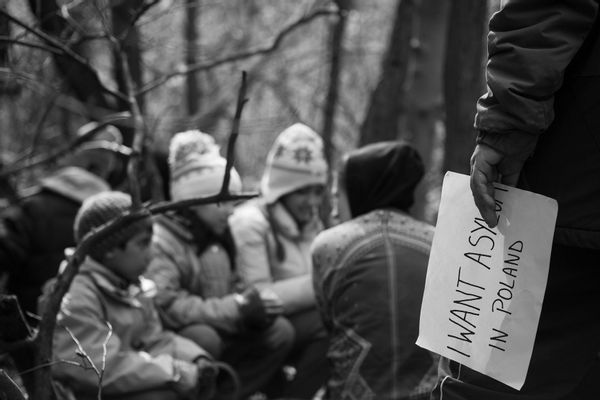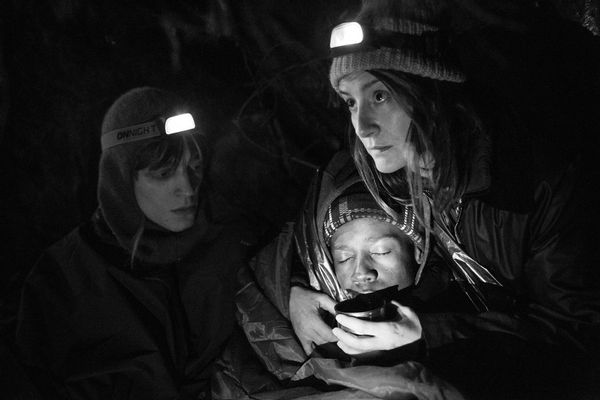
Agnieszka Holland’s astonishing epic “Green Border” presents the current refugee crisis from multiple points of view to illuminate the moral and emotional complexities of this hot button political issue. This film, shot in stark black and white, as if to magnify the gray morality and bleak experiences on display, is set in October 2021, in and around the forest between Belarus and Poland that separates the EU. It is the green border of the title.
Holland’s absorbing drama tells several intersecting stories. A Syrian family along with an Afghanistan woman Leila (Behi Djanati Atai), arrive in Belarus to cross into Poland and the safety of the EU. But situations occur that have Polish border guards, including, Jan (Tomasz Wlosok), send them back to Belarus. Meanwhile, a handful of activists try to help the refugees stranded in the forest get food, medical attention and to safety. After the activists meet Julia (Maja Ostaszewska), a psychologist who lives near the green border, she assists in their efforts and is changed by the experience.
These various characters and their storylines are all gripping because they feel so authentic. Perhaps too real; the film struck a nerve with the Polish President Andrzej Duda as well as right-wing members of the government, including the ministers of justice, education and the interior — all of whom spoke out against “Green Border” (though it was unclear if any of them had actually seen the film).
Nevertheless, Holland speaks truth to power, railing against injustice — a theme throughout her decades-long career. She shows how poorly border guards treat refugees and the networks that are created to help the refugees. “Green Border,” which features many indelible sequences (including the heartbreaking death of one character), is a rallying cry to address this global crisis head on and with humanity.
Holland spoke with Salon about her new film.
How did you develop the various stories and decide to present them in the way that you did?
It was quite special this work. I reacted to the reality in an urgent way. I tried to make the film about the events a few weeks after they became public. I contacted two colleagues who became my co-screenwriters. I asked them to join me and to make it quickly. I wanted the film to be part of the reality somehow. We started the very extended research. My cowriters had acquaintances and friends who have been involved in the medical and humanitarian activism on the border. We met with local people, activists, refugees and journalists who had been covering the issue, and a few border guards who anonymously wanted to tell their story. We saw all kinds of information or stories in the media — a photo or a video clip. After three or four weeks we had so much material the work was to eliminate it, to shape it.
The main question was what [approach] to take? Do we [present] one story, or one place, or one character? I decided that the story of migration and the response of Europe to the migration issue is well known, but what was happening on the borders had a lot of unknown specifics. I decided it was good to give faces and voices to many points of views and many experiences in the drama — refugees, who were dehumanized by the official propaganda, who are trapped in that terrible forest between Belarus and Poland and shifted back and forth very violently by uniformed forces, and the activists who were immediately named as “Putin’s useful idiots,” and the border guards who didn’t have a choice — a bit like the refugees. They are transported to the situation by the fact that they are serving as part of the armed forces and have to obey orders. At the same time, the most intelligent knew they are breaking the constitution and international law through violent pushbacks. Very few didn’t do it, or left. Many decided to take early retirement, or they escaped as a reaction to their everyday duty. All those points of views needed to have a voice.

Your film made headlines, angering the President of Poland and his ministers. “Green Border” features a scene where the refugees are bluntly told, “The Polish government doesn’t want you!” Can you discuss the reaction in Poland to your film?
It was rejected by the authorities at that time. It opened [in Poland] last September a few weeks before the general election, after eight years of authoritarianism and populist nationalistic party. Many people have been responsive to the film. The fact that I was attacked by the government, and the attacks have been unprecedented — they call me all the possible names, said I made Nazi propaganda, compared me as being Hitler, Goebbels, Stalin and Putin in one – it became good promotion. The film had good box office and deeply felt responses. The democratic opposition was afraid that the authoritarian regime could use the film to spread even more hate and create some nationalistic hysteria. The film helped in the victory of the democratic opposition.
Unfortunately, nine months later, the democratic opposition was very vocal against the practices at the border made by the previous regime is using the same language and is acting in a somehow worse way. They recently ordered soldiers to shoot the migrants practically with no limitations — which means, no punishment — which is shocking to me. But that reflects what Europe is today. That happened around the European elections, which trigger all kinds of nationalistic, xenophobic and populist reactions among democrats and populists. They are competing about who is more patriotic, strong and decisive. And because they are not in a position of government, it is good to show their determination on the border.
I started to receive threats and was quoted by politicians as someone who is mistaken and naïve, and who doesn’t understand the stakes — the typical voices saying all the racist and hateful remarks, “You and people like you want to let everyone in, and they are terrorists and Putin’s agents, and if you like them so much, take them under your roof.” Five percent of the population is supporting the shooting of migrants by the soldiers. Society is ready to kill. I have been expecting things would go in this direction since 2015. Politicians didn’t want to analyze the situation and look for the rational and difficult solutions. The migration issue will shape the future of Europe and America — and it will not be a nice future.
What details did you discover researching the activists?
The activists are a special race of people. Many people became activists without thinking about it. They live in the place, meet a person in need, open their arms, and are forced by the situation to continue. Several are still doing it after three years, and some have had nervous breakdowns after a year or so because it’s a lot of stress and tension and despair and adrenaline and satisfaction as well and frustration. You help someone in a bad condition in the forest and leave them. They can be pushed back to Belarus, and God knows what happens to them. It is interesting and dramatic. It is a radical choice to be an activist. But some people respond to the call because it’s not a choice. Some are radicalized and do not care about laws, and they do things against national treaties and the Polish constitution. They do things that are much more anarchistic. Those groups are acting in a more ordered way and belong to the bigger organizations. They want to do things their way, which causes conflicts, as I show in the film. What are the limits of this activism? What does it mean when are you breaking the law? If the state fails, and you have to replace the state, you have to make choices that are dangerous for your life. There is so much drama in this situation and so many human destinies.
What observations do you have about how ordinary citizens react to this topical issue? It’s easier to fear than to understand. Your film creates understanding.
I hope so. I tried not to be preachy. I wanted to show how difficult it is for everybody. I tried to find the humanity.

Can you talk about how you approached the film visually? The black and white cinematography is effective, but so too are the panning and tracking shots through the forest, the overhead shots of the forest, and some of the urgent scenes where the characters are on the run. Your create a very visceral "You are there" feeling.
We wanted the rawness of a documentary, and black and white gives you some metaphorical dimension. It becomes timeless. It becomes a reality from 1940 or 2024. The tracking shots express what the characters are going through. They are constantly on the run. Moments of rest and quiet are rare, but because they are so rare, they are also very precious and beautiful. The challenge was how to make a film about the refugee crisis in black and white that’s two hours and 40 minutes long with three different storylines and keep audiences’ attention and not have them disconnect with the film. That was the professional and artistic challenge and I think we’ve passed it quite well.
You have! The emotions are palpable even when the action is harrowing. There are painful scenes of guards separating the refugees, or when a character suddenly dies. What can you say about staging the chaos?
I had fantastic cinematographer. My daughter also came and helped me for some scenes because it was difficult to control. We had very little time; we shot in 24 days. I invited two young women directors to collaborate and codirect with me. We divided into parallel units to shoot so much footage. We had, as a reference, some blurry clips made by refugees and some guards posted on the internet so we can feel the fear and speed of everything and the violence that was very palpable. You try to recreate it. When I explained what the scene should look like, and we staged it as we shot it, the actors and extras found different ways to deal with situation. We were running with the camera and capturing it like it was like reportage from a war scene. When I analyzed it, I realized what I was missing from storytelling, so we did some precise shots not to miss the point.
You have long addressed issues of injustice in your films, most recently, in “Charlatan” and “Mr. Jones.” What are your thoughts about how cinema can change minds in general and how “Green Border” can foment change?
You need many more voices like mine to change something in a substantial way. I have questions when I showed the film in different countries. I tell them that I don’t think the film will change the world, and a young girl in France said, “Maybe your film will not change the world, but it certainly changed my world.” That is my ambition — to find enough individuals to change their vision of things.
“Green Border” opens in New York on June 21 and Los Angeles on June 28 with national rollout to follow.







